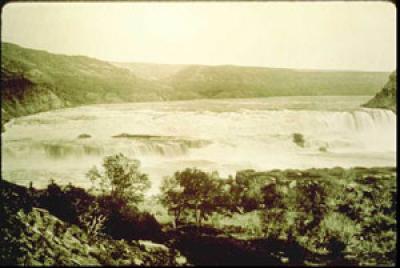History
Great Falls' history starts with the Missouri River and the waterfalls from which it gets its name. Where the City now sits, the Missouri River drops over 500 feet in a series of rapids and five waterfalls – the "great falls" of the Missouri.
Before the Louisiana Purchase, the Piegan (Blackfeet) and other tribes hunted and lived in the area. When Lewis and Clark explored the region in 1805, they could hear the falls from seven miles away. It took them nearly a month to get around the falls by land. Before they left, they celebrated the Fourth of July at White Bear Island.
Based on Lewis and Clark's Journals, Paris Gibson traveled from Fort Benton to see the falls. He saw the falls, the Sun and Missouri Rivers, and the wide, productive plain between the mountain ranges – a perfect place for a City. Gibson shared his plans with railroad owner James Hill. Hill knew that his railroad could benefit from a city in the area, so he gave Gibson money for the new City. With Hill's backing, Gibson founded Great Falls in 1884.
An engineer, Gibson laid out the streets in a precise, arrow-straight pattern. Believing that beauty was important for a city, he made sure that elm, ash, and fir trees were planted on every street and boulevard. He also set aside 886 acres for city parks.
With the construction of the dams and the installation of electric street lights, Great Falls became known as "The Electric City." This Electric City was home to the largest Opera House between Minneapolis and Spokane.
A City of firsts for Montana, Great Falls had the first:
- Fire Bell
- Elected African American
- Female Newspaper Editor
- Motorized Firefighting Apparatus
- African American Public Library Director
- Female Firefighter
Great Falls embraces its rich and diverse past while looking to the future, reflected in its:
- Deeply rooted history: From the First Peoples' Buffalo Jump to the Lewis and Clark Expedition and Charles M. Russell's legacy, the City remembers its past.
- Military influence: Malmstrom AFB and the Montana Air National Guard are integral parts of Great Falls' unique cultural landscape.
- Thriving arts scene: From symphonies and plays to interactive museums and vibrant street art, Great Falls offers a variety of artistic expressions.
- Focus on learning: Museums cater to contemporary art and interactive learning for all ages.
Great Falls is an exciting community of over 60,000 people with various recreational opportunities for citizens and visitors alike.

